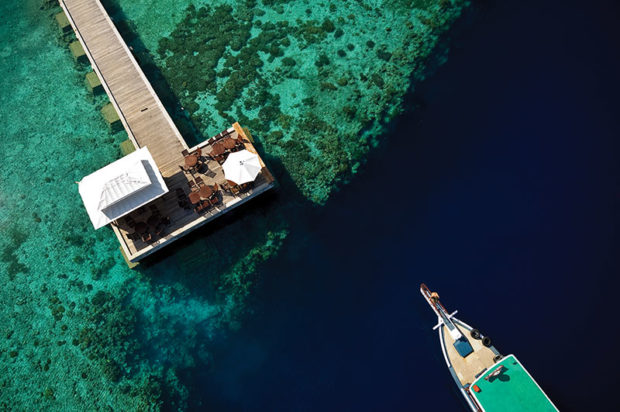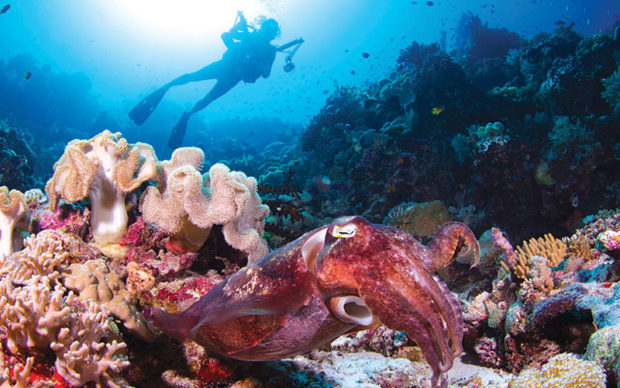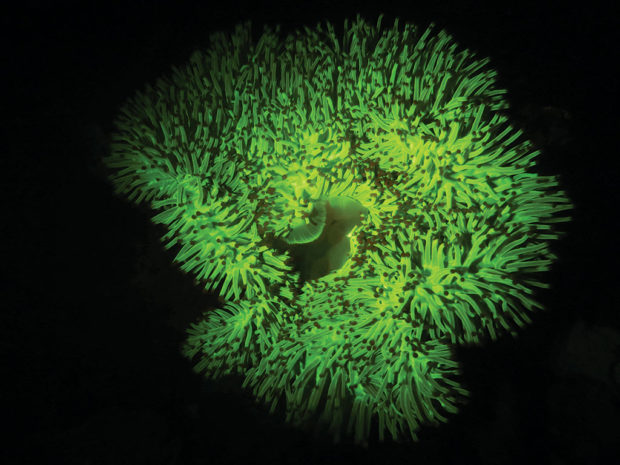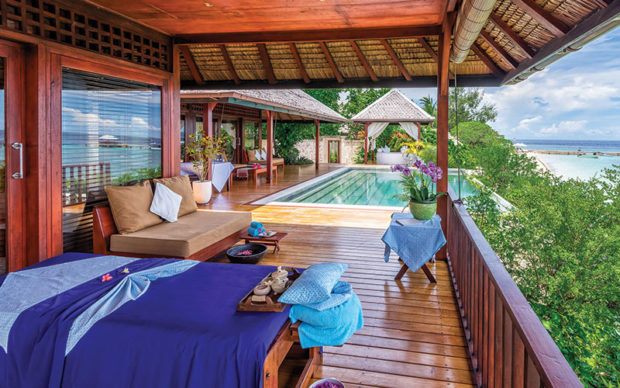The dive centre at the end of the universe
Eric Vohr takes a private jet to explore Indonesia’s Eden – Wakatobi

Sometimes, you have to travel to the end of the world to find spectacular diving; Wakatobi Dive Resort is one of those places.
The name Wakatobi is a portmanteau of the four main Tukangbesi Islands in the southeastern corner of Sulawesi, Indonesia: Wangi-Wangi, Kaledupa, Tomia, and Binongko. Roughly 10 miles (16km) off the east coast of Borneo in the Indian Ocean, it takes two-and-one-half-hours to get here on a private chartered flight from Bali. This might seem like a bit of a haul, but it’s actually brief, compared to the three days it took founder Lorenz Mäder to get here by boat in the late 1990s.
The excitement builds as you fly on a special charter plane with the rest of Wakatobi’s guests over the remote islands and pristine reefs that make up this part of the world. Truly in the middle of nowhere, Wakatobi Dive Resort lies on the white-sand shores of a tiny island in southeast Sulawesi called Pulau Tolandona, adjacent to its better-known and bigger brother, Tomia.
As you climb down from the plane onto the tarmac of the tiny airstrip on Tomia, the gentle tropical breeze welcomes you to a land that time forgot. Imagine what Bali looked like a hundred years ago, and you get the idea: small fishing villages, crystal cerulean water, and miles and miles of empty topical beaches fringed with swaying palm trees. A short boat takes you across a narrow channel to the resort, which blends naturally and seamlessly with the unspoiled natural beauty here.

Reef biodiversity
For divers, however, this is much more than just a tropical paradise. Eighty-five percent of the world’s coral reefs are located in the Indo-Pacific “Coral Triangle”, and Wakatobi Dive Resort is in the very epicenter of this coral reef biodiversity. As such, the waters around the resort boast more than 400 species of coral and 700 species of fish.
One of the factors that add significantly to the abundance of sea life here is the lack of damaging run-off from large rivers or urban centers, which can destroy reefs via siltation and pollution. The region also has a perfect temperature for coral growth (77-84°F/25-29°C), and an optimal average depth of 66 feet (20m). (Shallow waters have too much temperature fluctuation and disruptive wave/surge action and deep waters diminish the light, which decreases diversity.)
Wakatobi’s reefs are some of the few worldwide that are actually growing…recently designated as a reserve
In addition to perfect natural conditions for healthy marine life, Mäder and his team have gone to great lengths to preserve the waters and reefs around the resort. As any visitor to Asia knows, over-fishing is an ever-present threat here. On a recent sailing trip to a remote archipelago in Myanmar, we encountered an army of squid boats illuminating the night horizon in all directions with their powerful lights.
To help protect the flora and fauna at Wakatobi, Mäder made a deal with the local fishermen. In return for providing running water, electricity, job opportunities, and community financial support, locals have agreed to curtail damaging fishing practices and safeguard the reefs. This conservation effort has been such a great success, Wakatobi’s reefs are some of the few worldwide that are actually growing; in fact, UNESCO recently designated the region as a Marine Biosphere Reserve.

Abundant life
Wakatobi Dive Resort’s staff take guests to more than fifty mapped and named dive sites, all within a short distance of the dive center. Of course, this represents only a fraction of the wealth of great dive locations here.
Many of these dive sites include shallow reefs that are easily accessible for snorkeling, so those who are not avid divers can also join in the fun. The resort also provides extensive courses for guests who want to learn how to dive or expand their existing knowledge and skills.
Wakatobi’s extensive biodiversity means you’ll see a lot of critters of all shapes and sizes, including my favourite, nudibranchs. These other-worldly, space-ship-like critters never fail to amaze me with their insane shapes and colours. I counted at least twenty different species over my five days of diving here. In addition, I saw multitudes of flatworms, tiny shrimps, and pipefish.
Wakatobi is known for its abundance of another special little creature, pigmy sea horses. You’ll need one of the resort’s expert guides to help you find these little guys, as they are super well-camouflaged. You generally dive with the same guide during your entire stay at Wakatobi, so he or she knows what you want to achieve with your dives and thus can help you have the best possible experience underwater. Our guide was a local man named Muji who had an eagle eye for pigmy seahorses and nudibranchs. Not only did he help us locate these hard-to-find critters, but he also took the time post-dive to help us properly identify each one for our dive log — an often-daunting task.

Flouro experience
An especially unique experience we encountered on this trip was fluo diving (a.k.a. fluorescent diving, fluoro diving, UV diving or glow diving). Wakatobi Dive Resort is the first dive operator I’ve encountered who offers this alternative way to enjoy the undersea world — in fact, it was the first I’d ever heard of it.
For those who have not yet experienced this special type of diving, it’s basically night diving using a UV light and a special yellow filter on your mask, which together unveil amazing and unexpected fluorescent colours that are otherwise invisible. Fluorescence happens because some marine animals and coral absorb high-energy UV light and instantly re-emit it as colourful low-energy light. This is different from phosphorescence, where animals store light and re-emit it over time, glowing long after the original light source is gone.
Interestingly enough, divers did not discover fluorescence in marine life until recently. Even more puzzling, nobody knows why some animals glow, why they give off a specific colour and why some don’t glow at all (even different members of the same species don’t always glow the same way).
Safety at Wakatobi Dive Resort is always paramount, so before our fluo dive, our guide gave us a detailed and informative training session. For additional safety, they chose a site we had already dived during the day, so we would have a rough idea of the underwater geography. This turned out to be a very good idea, as UV torches provide less light than normal night-diving torches, making it even harder to navigate.
My first fluo encounter was the amazing yellow-green of a normally dull brain coral. Next to the brain coral was a bright orange glowing whip coral covered with blue and yellow sponges at its base, and tiny (usually invisible) sea lice glittering in an electric orange that seemed to scream, “Look what I can do!” I also saw shocking pink glowing soft coral and small, rainbow-coloured anemones. Even boring lizardfish, which are the same colour as sand during the day, suddenly sparkled in a bright green under my fluorescent light.

Something for everyone
The resort provides three boat dives per day and unlimited house reef dives. It maintains a high guide-to-guest ratio, so there are never more than four divers per guide. That means we always felt safe, got all the personal attention and guidance we needed and never felt rushed or guilty for lingering at one spot to gaze at something especially fascinating.
In spite of all the great diving, I highly recommend taking at least one morning or afternoon off to enjoy the resort on land. There’s a quaint traditional fishing village you can visit, or you can view some of the unique bird life on the island’s many peaceful nature trails.
We always felt safe, got all the personal attention and guidance we needed and never felt rushed
If you’re looking for more adventure, Wakatobi also offers kayaking, stand-up paddle boarding, and kite surfing. It turns out that in addition to top-notch diving, this region also has near-perfect conditions and topography for kite surfing. The resort has already hosted some pro kite surfers who all seem to agree that its “rips” here.
If you’re looking for some down time, there’s nothing better than simply lounging in your beach chair under swaying palm trees on the white sand beach in front of your private bungalow, while being serenaded by the small ripples of the resort’s gentle bay.
Those who enjoy abundant and diverse marine life and unspoiled natural beauty and want to really get away from it all will love Wakatobi Dive Resort. The waters here provide a level of sheer diving pleasure that rivals any dive site I’ve visited to date, and Wakatobi Dive Resort not only has the perfect setting to enjoy and explore this amazing dive Mecca, but the eco-minded owners are working hard to preserve and protect this magical spot so generations of divers can enjoy it for years to come.
To visit the last place you’ll ever want to be, check out: www.wakatobi.com

Leave a Comment







